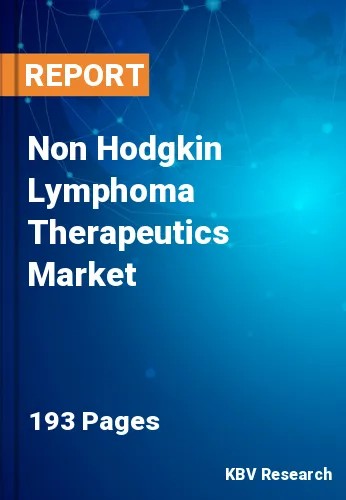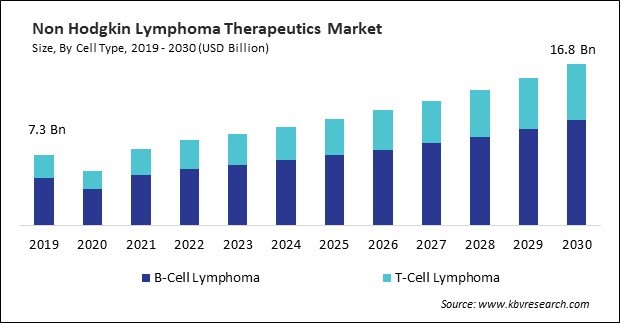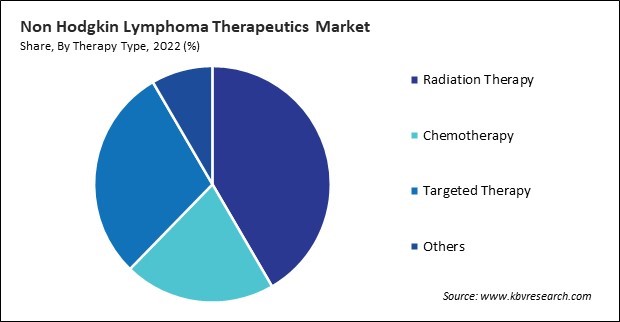
The Global Non Hodgkin Lymphoma Therapeutics Market size is expected to reach $16.8 billion by 2030, rising at a market growth of 8.4% CAGR.
North America has been at the forefront of developing and implementing immunotherapies, providing new avenues for treating NHL, especially in relapsed or refractory cases. Therefore, the North America region captured $3,690.9 million revenue in the market in 2022. Non hodgkin lymphoma is more commonly diagnosed in older individuals, and the risk of NHL generally increases with age in Canada. As the senior population grows, there may be a corresponding increase in the number of NHL cases in Canada. The demand for healthcare services, including cancer diagnosis and treatment, may increase with the growing senior population in Canada.

High-dimensional flow cytometry and advanced immunophenotyping techniques enhance the characterization of lymphoma cells. Improved cell profiling contributes to accurate subtyping, aiding treatment selection and prognosis determination. Advances in cytogenetic analysis and FISH techniques enhance the detection of chromosomal abnormalities associated with specific NHL subtypes. Improved cytogenetic profiling aids in risk stratification and informs treatment decisions, contributing to personalized therapeutic strategies. Therefore, it is expanding significantly due to the growing prevalence of respiratory diseases. Additionally, increased awareness and screening programs contribute to the early detection of non-hodgkin lymphoma. Early detection allows prompt treatment, positively impacting patient outcomes and driving the demand for therapeutic options. An increase in the number of HIV/AIDS cases globally. HIV/AIDS is a known risk factor for NHL, and the rise in HIV/AIDS cases contributes to the overall incidence and therapeutic demand. Thus, rising incidence of non-hodgkin lymphoma has been a pivotal factor in driving the growth of the market.
Further, the pandemic led to disruptions in routine healthcare services, including delays in cancer screenings, diagnostic procedures, and elective treatments. Oncologists adapted treatment plans to minimize hospital visits and reduce the risk of infection for vulnerable patients. Many clinical trials were temporarily halted or delayed due to safety concerns, resource allocation, and logistical challenges. This disruption affected the progression of novel therapies through the development pipeline, potentially delaying access to innovative treatments for NHL. Disruptions in the global supply chain affected the availability of certain drugs and therapeutic agents. These innovations may lead to long-term changes in how healthcare is delivered, providing more patient-centric and flexible solutions in the future. Thus, the COVID-19 pandemic had a moderate effect on the market.
However, the high cost of novel therapies strains healthcare budgets and reimbursement systems. Healthcare systems may face challenges in allocating resources, potentially leading to delays in adopting new treatments or restrictions on their availability. Delays in reimbursement approvals may hinder the timely entry of novel therapies into the market. Manufacturers may face challenges in recovering development costs, potentially slowing down research and development initiatives. Payers and insurers may experience financial strain due to the high cost of covering novel therapies. This strain can lead to increased premiums, out-of-pocket patient costs, or reluctance from payers to cover certain therapies. Thus, the high cost of novel therapies can slow down the growth of the market.
 Drivers
Drivers  Restraints
Restraints Based on therapy type, the market is classified into chemotherapy, radiation therapy, targeted therapy, and others. In 2022, the radiation therapy segment dominated with maximum revenue share. Radiation therapy is particularly effective for localized disease, where cancer is confined to a specific area. Its precision allows for targeting cancer cells while minimizing damage to surrounding healthy tissues. Radiation therapy can be combined with other treatment modalities, such as chemotherapy or immunotherapy, to enhance the overall effectiveness of the treatment. This combination approach may lead to better outcomes for patients with non hodgkin lymphoma. Advances in radiation therapy technology, such as intensity-modulated radiation therapy (IMRT) and image-guided radiation therapy (IGRT), have improved the precision and accuracy of treatment delivery. This can result in better tumor targeting and reduced side effects.

By cell type, the market is categorized into B-cell lymphoma and T-cell lymphoma. The T-cell lymphoma segment covered a considerable revenue share in the market in 2022. HDAC inhibitors, such as romidepsin and belinostat, have been approved for certain T-cell lymphomas. They work by modifying the activity of proteins involved in gene expression. T-cell lymphomas may be treated with allogeneic stem cell transplantation, where healthy stem cells from a donor are used to replace damaged or cancerous cells. This approach can offer a potential cure for some patients. Traditional chemotherapy is still a part of the treatment regimen for T-cell lymphomas. Combinations of chemotherapy agents with other targeted therapies or immunotherapies are explored to improve treatment outcomes.
Free Valuable Insights: Global Non Hodgkin Lymphoma Therapeutics Market size to reach USD 16.8 Billion by 2030
Region-wise, the market is analysed across North America, Europe, Asia Pacific, and LAMEA. In 2022, the Asia Pacific region acquired a significant revenue share in the market. The Asia Pacific region has become increasingly involved in clinical trials and research collaborations. Telemedicine facilitates access to expert consultations, especially in remote or underserved areas, contributing to improved patient care and treatment planning in Asia Pacific. HSCT programs are evolving in the Asia Pacific region. The pharmaceutical industry is investing in research and development in the Asia Pacific region.
| Report Attribute | Details |
|---|---|
| Market size value in 2022 | USD 8.9 Billion |
| Market size forecast in 2030 | USD 16.8 Billion |
| Base Year | 2022 |
| Historical Period | 2019 to 2021 |
| Forecast Period | 2023 to 2030 |
| Revenue Growth Rate | CAGR of 8.4% from 2023 to 2030 |
| Number of Pages | 193 |
| Number of Tables | 260 |
| Report coverage | Market Trends, Revenue Estimation and Forecast, Segmentation Analysis, Regional and Country Breakdown, Porter’s 5 Forces Analysis, Company Profiling, Companies Strategic Developments, SWOT Analysis, Winning Imperatives |
| Segments covered | Cell Type, Therapy Type, Region |
| Country scope |
|
| Companies Included | Pfizer Inc., F. Hoffmann-La Roche Ltd, Sanofi S.A., AbbVie, Inc., Novartis AG, GlaxoSmithKline PLC, Johnson & Johnson (Johnson & Johnson Services, Inc.), Takeda Pharmaceutical Company Limited, Bayer AG, Bristol-Myers Squibb Company |
By Cell Type
By Therapy Type
By Geography
The Market size is projected to reach USD $16.8 billion by 2030.
Technological advancements in diagnostic tools are driving the Market in coming years, however, Lack of standardized treatment guidelines restraints the growth of the Market.
Pfizer Inc., F. Hoffmann-La Roche Ltd, Sanofi S.A., AbbVie, Inc., Novartis AG, GlaxoSmithKline PLC, Johnson & Johnson (Johnson & Johnson Services, Inc.), Takeda Pharmaceutical Company Limited, Bayer AG, Bristol-Myers Squibb Company.
The expected CAGR of this Market is 8.4% from 2023 to 2030.
The B-Cell Lymphoma segment is leading the Market by Cell Type in 2022; thereby, achieving a market value of $10.9 billion by 2030.
The North America region dominated the Market by Region in 2022, and would continue to be a dominant market till 2030; thereby, achieving a market value of $6.5 billion by 2030.
Our team of dedicated experts can provide you with attractive expansion opportunities for your business.
